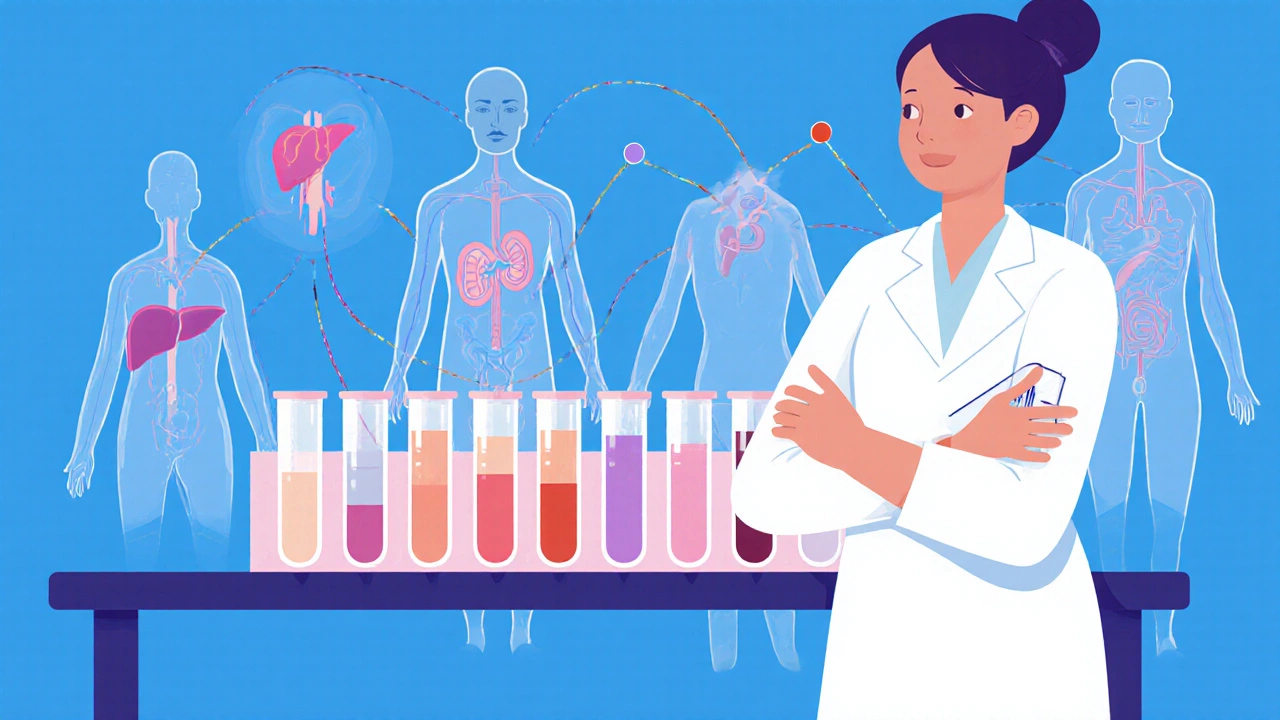
- Oct, 12 2025
- 0
Blood Test Result Checker
Check if your blood test values are within normal ranges and get insights about your health status. Enter your values below and click "Check Results" to see if your levels are normal, borderline, or require medical attention.
Key Takeaways
- A full body blood test bundles several core panels that give a snapshot of overall health.
- The most common components are a complete blood count, basic metabolic panel, lipid panel, thyroid test, vitamin D, hemoglobin A1c, and liver/kidney panels.
- Preparation is simple: fast for 8‑12 hours, stay hydrated, and avoid strenuous exercise before the draw.
- Results guide lifestyle tweaks, medication decisions, and early detection of chronic conditions.
Wondering what a full body blood test actually covers? Below is a plain‑English walk‑through of every lab that typically shows up when you ask your doctor for a comprehensive health screen.
Full Body Blood Test is a bundled set of laboratory panels designed to evaluate the major organ systems and metabolic pathways in one visit. It aims to catch hidden issues before symptoms appear, giving both patients and clinicians a data‑driven starting point for preventive care.
What Is Included in the Core Panels?
The backbone of a full body blood test consists of four to six standard panels. Each panel measures a group of related biomarkers, and together they paint a broad picture of your health.
Complete Blood Count (CBC)
The CBC counts red cells, white cells, and platelets. It tells you if you’re anemic, if there’s an infection, or if your clotting ability is off. Typical values: hemoglobin 13‑17g/dL (men), 12‑15g/dL (women); white blood cells 4‑11×10⁹/L.
Basic Metabolic Panel (BMP)
The BMP checks electrolytes (sodium, potassium, chloride), glucose, calcium, and kidney markers (creatinine, BUN). It helps assess fluid balance, acid‑base status, and early kidney function. Normal sodium 135‑145mmol/L; creatinine 0.7‑1.3mg/dL.
Lipid Panel
This panel measures total cholesterol, LDL, HDL, and triglycerides. High LDL or low HDL signals cardiovascular risk. Desirable LDL <100mg/dL; triglycerides <150mg/dL.
Thyroid Stimulating Hormone (TSH)
TSH gauges thyroid function. Elevated TSH suggests hypothyroidism; low TSH points to hyperthyroidism. Typical range 0.4‑4.0mIU/L.
Vitamin D Test
Most labs report 25‑hydroxy vitamin D. Levels below 20ng/mL indicate deficiency, which can affect bone health and immunity.
Hemoglobin A1c
A1c reflects average blood sugar over the past 2‑3 months. A result under 5.7% is normal; 5.7‑6.4% signals pre‑diabetes; ≥6.5% meets diabetes criteria.
Liver Function Tests (LFT)
LFTs include ALT, AST, alkaline phosphatase, and bilirubin. Elevated enzymes may indicate hepatitis, fatty liver, or medication‑induced injury.
Optional Add‑Ons You Might See
Depending on age, medical history, or physician preference, labs often add one or two of the following:
- CRP (C‑reactive protein) - an inflammation marker linked to heart disease.
- Iron studies (ferritin, total iron‑binding capacity) - useful if anemia is suspected.
- Hormone panels (testosterone, estrogen) - common in endocrine evaluations.
- Advanced lipid sub‑fraction testing - for patients with borderline cholesterol.

How to Prepare for the Test
Preparation is straightforward, but a few habits improve accuracy:
- Fast for 8‑12hours. Water is fine; avoid coffee, tea, or juice.
- Stay hydrated. Dehydration can falsely raise hemoglobin and electrolytes.
- Avoid heavy exercise the day before - intense workouts can spike CK and affect white‑cell counts.
- Tell the lab about any supplements (especially vitamin D or iron) because they can skew results.
Interpreting the Results: What to Look For
Most labs provide reference ranges next to each value. Here’s a quick cheat‑sheet for the most common flags:
| Marker | Typical Range | Possible Concern if Outside Range |
|---|---|---|
| Hemoglobin (CBC) | 13‑17g/dL (M), 12‑15g/dL (F) | Low → anemia; High → dehydration or polycythemia |
| Glucose (BMP) | 70‑99mg/dL fasting | High → pre‑diabetes/diabetes; Low → hypoglycemia |
| LDL Cholesterol | <100mg/dL | High → cardiovascular risk |
| TSH | 0.4‑4.0mIU/L | High → hypothyroidism; Low → hyperthyroidism |
| 25‑OH Vitamin D | 30‑100ng/mL | Low → bone weakness, immune issues |
| Hemoglobin A1c | 4.0‑5.6% | ≥6.5% → diabetes |
| ALT (LFT) | 7‑56U/L | Elevated → liver inflammation |
If a value falls outside the reference range, your doctor will consider trends, symptoms, and repeat testing before making a diagnosis.
When Should You Get a Full Body Blood Test?
You don’t need this massive screen every year unless you have risk factors. Ideal times include:
- Annual check‑up for adults over 40.
- Before starting a new medication that can affect liver or kidneys.
- If you have a family history of heart disease, diabetes, or thyroid disorders.
- When you’ve experienced unexplained fatigue, weight changes, or frequent infections.

Cost, Insurance, and Where to Get It
In the UnitedStates, a full body blood test typically costs between $150‑$300 if you pay out‑of‑pocket. Many insurance plans cover the test when ordered as a preventive service for adults over 45, but always verify with your provider.
Major labs (Labcorp, Quest) and most hospital outpatient clinics offer the panel. Some tele‑medicine platforms let you order the test online and drop it off at a local collection site.
Common Misconceptions
- My doctor can read the whole report in five minutes. Interpreting multiple panels takes time; doctors often focus on abnormal values first.
- “If the numbers look normal, I’m completely healthy.” Normal values are a snapshot; they don’t replace lifestyle assessment.
- “I need to repeat the test every month.” Most markers are stable; yearly or biennial testing is sufficient unless you’re managing a condition.
Next Steps After Receiving Your Results
Don’t panic over a single out‑of‑range number. Here’s a practical three‑step plan:
- Schedule a follow‑up appointment to discuss the report in context.
- If a value is borderline, ask whether lifestyle changes (diet, exercise, sleep) could normalize it before medication is considered.
- Keep a personal health log - track diet, activity, and symptoms - to help your clinician see patterns over time.
Frequently Asked Questions
How long does it take to get results?
Most labs return standard panels within 24‑48hours for in‑person draws. Complex hormone panels may need 3‑5days.
Do I need to fast for the vitamin D test?
No, vitamin D measurement isn’t affected by food. You can keep the same fasting schedule you use for the other panels.
Can I skip the lipid panel if I’m already on statins?
Doctors usually keep the lipid panel to monitor how well the medication works and to adjust dosage if needed.
What does a high CRP mean?
CRP rises with any inflammation - infections, autoimmune disease, or even intense exercise. A persistently high CRP should prompt a deeper look at cardiovascular risk.
Is a full body blood test covered for people under 40?
Coverage varies. Some insurers offer it as a preventive benefit for high‑risk individuals, while others require a physician’s order for specific panels.
Can I get the test done at a pharmacy?
Many large chain pharmacies now have on‑site labs that can draw the blood and send it to a partner laboratory for analysis.
How often should I repeat the test?
For most healthy adults, once every 1‑2years is enough. If you have a chronic condition, your doctor may schedule it more frequently to track treatment response.
Nikhil Verma
I'm a dedicated physician with a passion for exploring the intricacies of medicine, focusing on the unique healthcare challenges in India. I spend much of my spare time writing articles aimed at improving public understanding of health issues. Balancing my clinical practice and writing allows me to reach a wider audience, sharing insights and fostering a deeper appreciation for medical advancements. I derive immense satisfaction from both treating patients and engaging with readers through my writing.